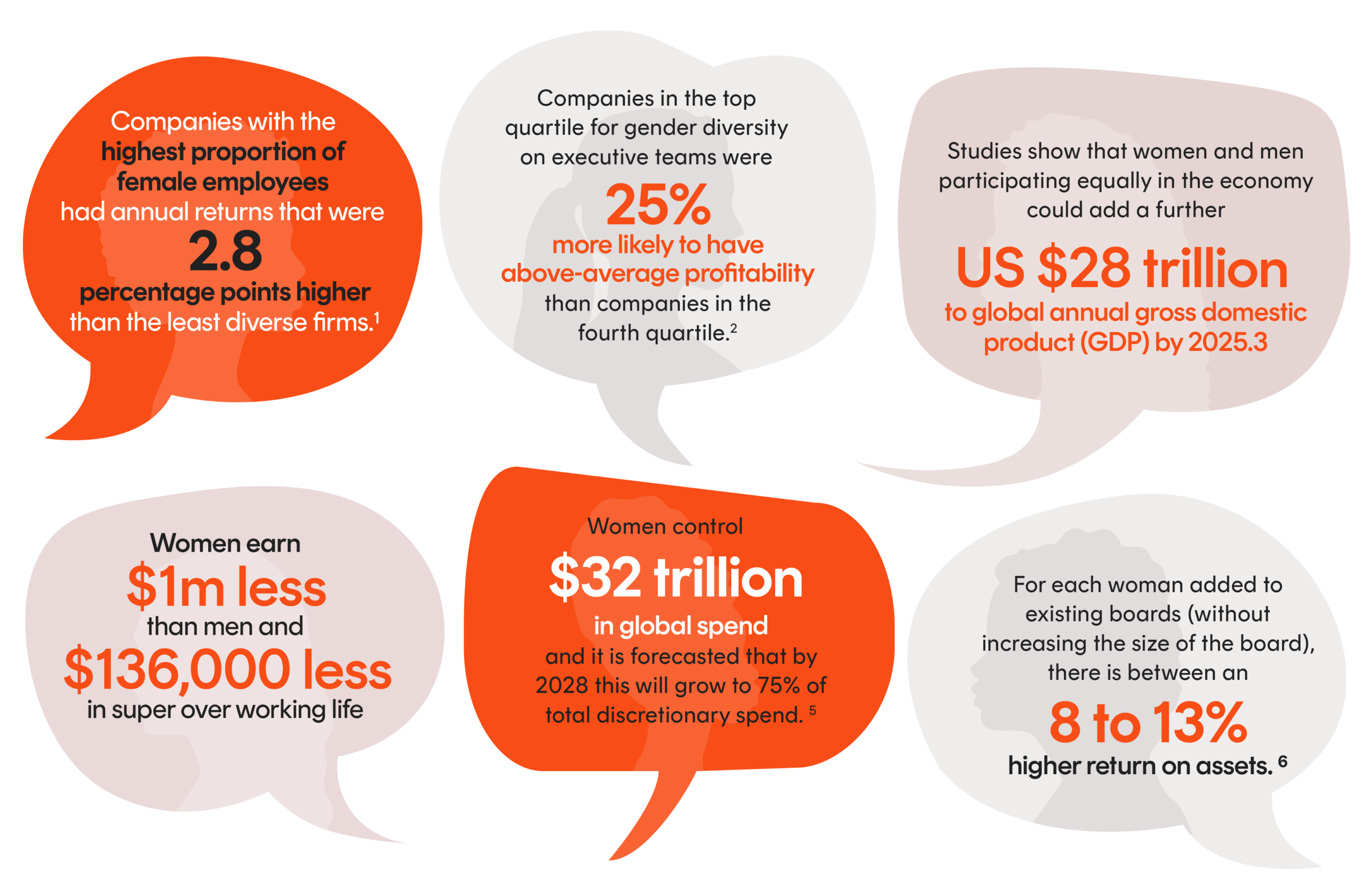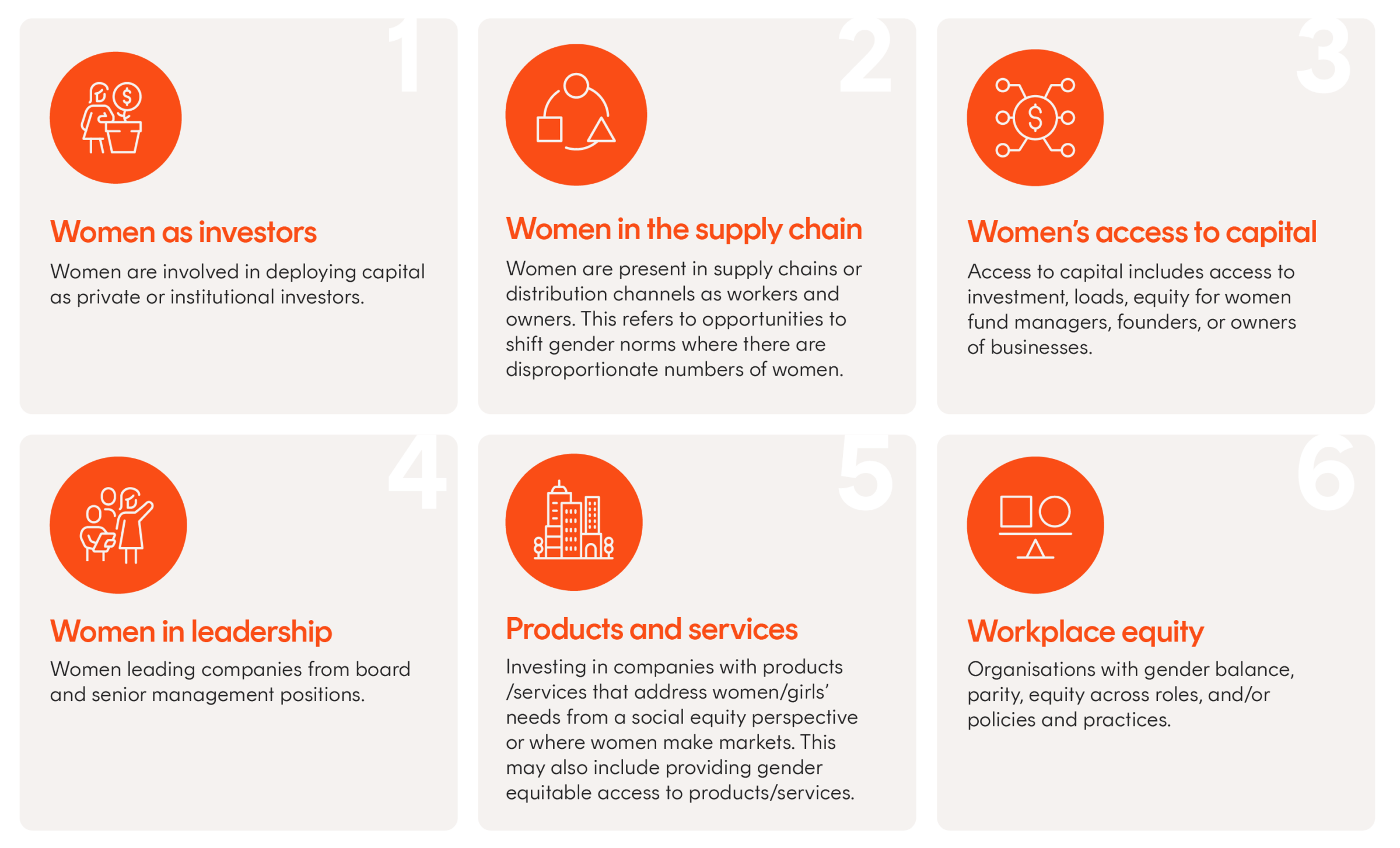Mind the gap: the role of gender equality in investing
At its core, gender equality is about ensuring that men and women have equal access to opportunities and resources, including education, healthcare, employment, and political representation. Numerous studies, including those by global institutions like the United Nations, have shown that gender equality significantly contributes to economic growth1. From a global perspective, achieving gender equality is crucial for sustainable development as highlighted in the United Nations Sustainable Development Goal 5 – Achieve Gender Equality and Empower all Women and Girls2. This specific goal underlines the vital importance of addressing various forms of discrimination, violence, and systemic inequalities that women and girls face globally.
Bridging the gap – from gender equality to Gender Lens Investing
Gender equality in investing started off with investors advocating for equal treatment of women in the workforce, reducing workplace discrimination, equal pay and increasing female representation in the C-suite. As the conversation around gender equality gained momentum, investors began to recognise that addressing gender issues could extend beyond ethical considerations and contribute positively to financial performance. This realisation marked the beginning of a transition from a general focus on gender equality to the emergence of Gender Lens Investing (GLI).
Studies have shown that organisations with higher levels of gender diversity, particularly in leadership roles, tend to have better financial performance, lower risk profiles, and enhanced capacity for innovation.
From margin to mainstream – making the case for Gender Lens Investing
GLI represents an investment philosophy not only seeking financial returns but aiming to advance gender equality and women’s empowerment. GLI offers several benefits, including the potential for financial returns and the ability to drive positive social change. We have outlined some of the key benefits of GLI below.
Making the case for Gender Lens Investing

-
Potential for improved financial returns: The most tangible benefit of GLI is its potential for enhanced financial returns. A growing body of research indicates that companies with higher levels of gender diversity, especially in leadership and governance, tend to outperform their less diverse counterparts. A study revealed that firms with the most gender-diverse executive teams were 25% more likely to experience above-average profitability than companies with the least gender diversity3.
- New markets: GLI contributes to the opening up of new market opportunities by focusing on products and services catering to women or addressing issues predominantly affecting women. Women, representing a significant portion of the global consumer market, drive a substantial amount of purchasing decisions. Investing in companies which understand and cater to this demographic can unlock new revenue streams and drive business growth.
- Promoting social change: By directing capital toward companies which actively support gender equality, investors can help break down systemic barriers faced by women in the workplace and society. This includes supporting businesses which provide solutions to issues affecting women, like healthcare and education, thereby contributing to the overall wellbeing and empowerment of women4.
- Financial inclusion: The rise of gender-focused ETFs has made GLI accessible to a broader range of investors, not just large institutions, or specialty funds. This democratisation means that individual investors can now contribute to and benefit from gender-diverse investing, aligning their portfolios with their values while seeking improved financial returns.
- Better economic outcomes: Investment in women could boost economic development, competitiveness, employment, and GDP. It is estimated that on average, across the OECD, a 50% reduction in the gender gap in labour force participation would lead to an additional gain in GDP of about 6% by 2030, with a further 6% gain (12% in total) if we completely closed the gap5.
Navigating the different approaches to Gender Lens Investing
GLI consists of multiple approaches, including investing in women-led funds, preferencing companies that have women in senior leadership roles, analysing a company’s approach to gender and diversity across its workforce and even supply chain, and investing in themes that align with improving gender equality and the rights and lives of women globally.
Another key approach is shareholder advocacy and engagement, where an investor uses their right as a shareholder to actively encourage companies to improve their policies and approach to gender equality. This could include voting against all-male boards, and nominating committee members for the lack of diversity at the time of re-election.
5% of all resolutions filed in 2022 in the US were on board diversity and 9% of all resolutions were on workplace diversity, along with several resolutions seeking transparency on racial and gender media pay data to assess pay gaps. It is important to note though that engagement itself is not a standalone strategy and is often used in conjunction with other approaches.
Various approaches to Gender Lens Investing

A work in progress – Understanding the challenges of Gender Lens Investing
GLI has emerged as a powerful strategy to align financial investments with the goal of gender equality. However, it faces its own set of unique challenges highlighted below.
One of the primary challenges in GLI is the lack of standardised, reliable gender-related data from companies and public institutions. Without standardised metrics, assessing a company’s commitment to gender equality can be difficult, leading to potential inaccuracies in investment decisions. Globally, the United Nations women’s global gender data program has been supporting efforts to improve regular production of standardised gender statistics, but as per its 2022 report, it will take 22 years for countries across the world to make all gender related data available6. In Australia, we will see the publication of company level data relating to gender pay gaps in 20247. While this is a significant step in increasing transparency, we believe there is a lot more work to be done on the gender-related data front.
Like greenwashing, gender washing occurs when companies overstate or misrepresent their commitment to gender equality to attract investments. Such misleading practices can undermine the credibility and effectiveness of GLI. It is therefore important for investors to carefully analyse a company or issuer’s commitment to gender equality by examining what lies under the hood.
Lack of market depth
In the unlisted funds market, private equity, venture capital and impact investing in women-led businesses or gender-focused projects are often not accessible to the average investor due to high minimum investment requirements. Furthermore, the amount of capital allocated to these fund managers and products is negligible relative to the size of the overall alternative assets market. Estimates suggest that there were 233 institutional-scale gender lens impact funds as of September 2021, with capital commitments of €18 billion12.
The road ahead for GLI is both promising and challenging, reflecting a growing awareness of gender equality’s critical role in sustainable development and economic growth. This investment approach, which deliberately focuses on investments that have a positive impact on women and girls, has gradually gained momentum in recent years. The underlying philosophy of GLI is not only about fairness and equality but also about recognising the unique value that women bring to the workforce, leadership, and entrepreneurship.
The Betashares Global Sustainability Leaders ETF (ASX: ETHI), the Betashares Australian Sustainability Leaders ETF (ASX: FAIR) and the Betashares Sustainability Leaders Diversified Bond ETF – Currency Hedged (ASX: GBND) include a gender screen relating to board diversity as part of their index methodology.
2 topics
3 stocks mentioned
3 funds mentioned

